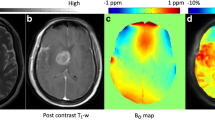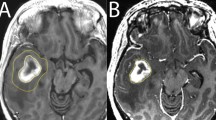Abstract
Objectives
The aim of this study was to characterize amide proton transfer (APT)-weighted signals in acute and subacute haemorrhage brain lesions of various underlying aetiologies.
Methods
Twenty-three patients with symptomatic haemorrhage brain lesions including tumorous (n = 16) and non-tumorous lesions (n = 7) were evaluated. APT imaging was performed and analyzed with magnetization transfer ratio asymmetry (MTR asym ). Regions of interest were defined as the enhancing portion (when present), acute or subacute haemorrhage, and normal-appearing white matter based on anatomical MRI. MTR asym values were compared among groups and components using a linear mixed model.
Results
MTR asym values were 3.68 % in acute haemorrhage, 1.6 % in subacute haemorrhage, 2.65 % in the enhancing portion, and 0.38 % in normal white matter. According to the linear mixed model, the distribution of MTR asym values among components was not significantly different between tumour and non-tumour groups. MTR asym in acute haemorrhage was significantly higher than those in the other regions regardless of underlying pathology.
Conclusions
Acute haemorrhages showed high MTR asym regardless of the underlying pathology, whereas subacute haemorrhages showed lower MTR asym than acute haemorrhages. These results can aid in the interpretation of APT imaging in haemorrhage brain lesions.
Key Points
• Acute haemorrhages show significantly higher MTR asym values than subacute haemorrhages.
• MTR asym is higher in acute haemorrhage than in enhancing tumour tissue.
• MTR asym in haemorrhage does not differ between tumorous and non-tumorous lesions.



Similar content being viewed by others
Abbreviations
- APT:
-
Amide proton transfer
- CEST:
-
Chemical exchange saturation transfer
- MT:
-
Magnetization transfer
- MTR asym :
-
Magnetization transfer ratio asymmetry
- ICH:
-
Intracranial haemorrhage
- RF:
-
Radiofrequency
- TR:
-
Repetition time
- TE:
-
Echo time
- TI:
-
Inversion time
- SNR:
-
Signal-to-noise ratio
- FLAIR:
-
Fluid attenuated inversion recovery
- PPM:
-
Parts per million
References
Jiang S, Yu H, Wang X et al (2016) Molecular MRI differentiation between primary central nervous system lymphomas and high-grade gliomas using endogenous protein-based amide proton transfer MR imaging at 3 Tesla. Eur Radiol 26:64–71
van Zijl PC, Yadav NN (2011) Chemical exchange saturation transfer (CEST): what is in a name and what isn't? Magn Reson Med 65:927–948
Ward KM, Aletras AH, Balaban RS (2000) A new class of contrast agents for MRI based on proton chemical exchange dependent saturation transfer (CEST). J Magn Reson 143:79–87
Wen Z, Hu S, Huang F et al (2010) MR imaging of high-grade brain tumors using endogenous protein and peptide-based contrast. Neuroimage 51:616–622
Zhou J, Lal B, Wilson DA, Laterra J, van Zijl PC (2003) Amide proton transfer (APT) contrast for imaging of brain tumors. Magn Reson Med 50:1120–1126
Zhou J, Payen JF, Wilson DA, Traystman RJ, van Zijl PC (2003) Using the amide proton signals of intracellular proteins and peptides to detect pH effects in MRI. Nat Med 9:1085–1090
Zhou J, Zhu H, Lim M et al (2013) Three-dimensional amide proton transfer MR imaging of gliomas: Initial experience and comparison with gadolinium enhancement. J Magn Reson Imaging 38:1119–1128
Zhou J, Zijl PCMV (2006) Chemical exchange saturation transfer imaging and spectroscopy. Prog Nucl Mag Res Sp 48:109–136
Zhou J, Hong X, Zhao X, Gao JH, Yuan J (2013) APT-weighted and NOE-weighted image contrasts in glioma with different RF saturation powers based on magnetization transfer ratio asymmetry analyses. Magn Reson Med 70:320–327
Englander SW, Downer NW, Teitelbaum H (1972) Hydrogen exchange. Annu Rev Biochem 41:903–924
Jones CK, Schlosser MJ, van Zijl PC, Pomper MG, Golay X, Zhou J (2006) Amide proton transfer imaging of human brain tumors at 3T. Magn Reson Med 56:585–592
Sun PZ, Zhou J, Sun W, Huang J, van Zijl PC (2007) Detection of the ischemic penumbra using pH-weighted MRI. J Cereb Blood Flow Metab 27:1129–1136
Tietze A, Blicher J, Mikkelsen IK et al (2013) Assessment of ischemic penumbra in patients with hyperacute stroke using amide proton transfer (APT) chemical exchange saturation transfer (CEST) MRI. NMR Biomed 27:164–174
Kogan F, Hariharan H, Reddy R (2013) Chemical Exchange Saturation Transfer (CEST) Imaging: description of technique and potential clinical applications. Curr Radiol Rep 1:102–114
Vinogradov E, Sherry AD, Lenkinski RE (2013) CEST: from basic principles to applications, challenges and opportunities. J Magn Reson 229:155–172
Scheidegger R, Wong ET, Alsop DC (2014) Contributors to contrast between glioma and brain tissue in chemical exchange saturation transfer sensitive imaging at 3Tesla. Neuroimage 99C:256–268
Xu J, Zaiss M, Zu Z et al (2014) On the origins of chemical exchange saturation transfer (CEST) contrast in tumors at 9.4 T. NMR Biomed 27:406–416
Sagiyama K, Mashimo T, Togao O et al (2014) In vivo chemical exchange saturation transfer imaging allows early detection of a therapeutic response in glioblastoma. Proc Natl Acad Sci U S A 111:4542–4547
Togao O, Yoshiura T, Keupp J et al (2014) Amide proton transfer imaging of adult diffuse gliomas: correlation with histopathological grades. Neuro Oncol 16:441–448
Bradley WG Jr (1993) MR appearance of hemorrhage in the brain. Radiology 189:15–26
Gomori JM, Grossman RI (1988) Mechanisms responsible for the MR appearance and evolution of intracranial hemorrhage. Radiographics 8:427–440
Parizel PM, Makkat S, Van Miert E, Van Goethem JW, van den Hauwe L, De Schepper AM (2001) Intracranial hemorrhage: principles of CT and MRI interpretation. Eur Radiol 11:1770–1783
Zheng S, van der Bom IM, Zu Z, Lin G, Zhao Y, Gounis MJ (2013) Chemical exchange saturation transfer effect in blood. Magn Reson Med 71:1082–1092
Wang M, Hong X, Chang CF et al (2015) Simultaneous detection and separation of hyperacute intracerebral hemorrhage and cerebral ischemia using amide proton transfer MRI. Magn Reson Med. doi:10.1002/mrm.25690
Zhu H, Jones CK, van Zijl PC, Barker PB, Zhou J (2010) Fast 3D chemical exchange saturation transfer (CEST) imaging of the human brain. Magn Reson Med 64:638–644
Zhou J, Blakeley JO, Hua J et al (2008) Practical data acquisition method for human brain tumor amide proton transfer (APT) imaging. Magn Reson Med 60:842–849
Kim M, Gillen J, Landman BA, Zhou J, van Zijl PC (2009) Water saturation shift referencing (WASSR) for chemical exchange saturation transfer (CEST) experiments. Magn Reson Med 61:1441–1450
Grad J, Bryant RG (1990) Nuclear magnetic cross-relaxation spectroscopy. J Magn Reson 90:1–8
Brown HPR (2015) Applied mixed models in medicine. 3rd edn. John Wiley & Sons
Zhou J, Wilson DA, Sun PZ, Klaus JA, van Zijl PCM (2004) Quantitative description of proton exchange processes between water and endogenous and exogenous agents for WEX, CEST, and APT experiments. Magn Reson Med 51:945–952
Mittl RL Jr, Gomori JM, Schnall MD, Holland GA, Grossman RI, Atlas SW (1993) Magnetization transfer effects in MR imaging of in vivo intracranial hemorrhage. AJNR Am J Neuroradiol 14:881–891
Zheng S, van der Bom IM, Zu Z, Lin G, Zhao Y, Gounis MJ (2014) Chemical exchange saturation transfer effect in blood. Magn Reson Med 71:1082–1092
Jones CK, Huang A, Xu J et al (2013) Nuclear Overhauser enhancement (NOE) imaging in the human brain at 7T. Neuroimage 77:114–124
Heo HY, Zhang Y, Jiang S, Lee DH, Zhou J (2015) Quantitative assessment of amide proton transfer (APT) and nuclear overhauser enhancement (NOE) imaging with extrapolated semisolid magnetization transfer reference (EMR) signals: II. Comparison of three EMR models and application to human brain glioma at 3 Tesla. Magn Reson Med. doi:10.1002/mrm.25795
Heo HY, Zhang Y, Lee DH, Hong X, Zhou J (2016) Quantitative assessment of amide proton transfer (APT) and nuclear overhauser enhancement (NOE) imaging with extrapolated semi-solid magnetization transfer reference (EMR) signals: Application to a rat glioma model at 4.7 tesla. Magn Reson Med 75:137–149
Lee DH, Heo HY, Zhang K et al (2016) Quantitative assessment of the effects of water proton concentration and water T changes on amide proton transfer (APT) and nuclear overhauser enhancement (NOE) MRI: The origin of the APT imaging signal in brain tumor. Magn Reson Med. doi:10.1002/mrm.26131
Zhao X, Wen Z, Huang F et al (2011) Saturation power dependence of amide proton transfer image contrasts in human brain tumors and strokes at 3 T. Magn Reson Med 66:1033–1041
Acknowledgments
The scientific guarantor of this publication is Seung-Koo Lee, MD, Ph.D. The authors of this manuscript declare relationships with the following companies: Philips Healthcare. This study has received funding by the Ministry of Science, ICT & Future Planning (2014R1A1A1002716) and National Institute of Health (P41 EB015909, R01 CA166171, R01 EB009731). One of the authors has significant statistical expertise. Institutional Review Board approval was obtained. Written informed consent was waived by the Institutional Review Board. Methodology: retrospective, cross sectional study, performed at one institution.
Author information
Authors and Affiliations
Corresponding author
Rights and permissions
About this article
Cite this article
Jeong, HK., Han, K., Zhou, J. et al. Characterizing amide proton transfer imaging in haemorrhage brain lesions using 3T MRI. Eur Radiol 27, 1577–1584 (2017). https://doi.org/10.1007/s00330-016-4477-1
Received:
Revised:
Accepted:
Published:
Issue Date:
DOI: https://doi.org/10.1007/s00330-016-4477-1




